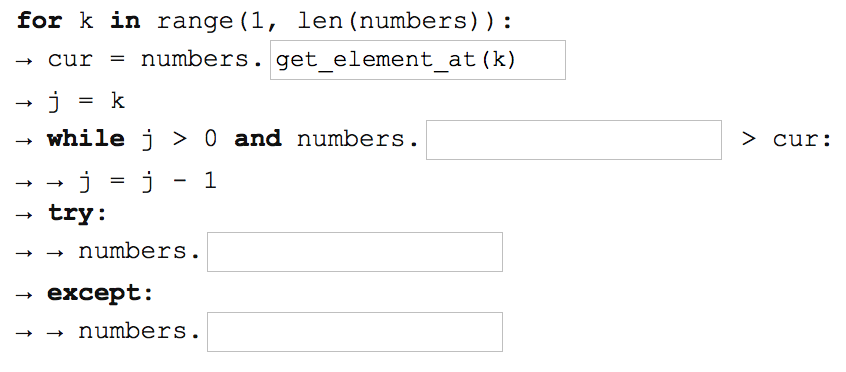Question
Suppose you have a sentineled, doubly-linked list class and an object of that class called numbers. The code segment below correctly performs an insertion sort
Suppose you have a sentineled, doubly-linked list class and an object of that class called numbers. The code segment below correctly performs an insertion sort on that list, but the list interactions have been removed. Fill in the missing code. Be certain that the implementation uses as few steps as possible with this structure.

I believe the first blank that I filled in is correct.
These are the possible list interactions:
def append_element(self, val): # increase the size of the list by one, and add a # node containing val at the new tail position. this # is the only way to add items at the tail position.
def insert_element_at(self, val, index):
# assuming the head position (not the header node) # is indexed 0, add a node containing val at the # specified index. If the index is not a valid # position within the list, raise an IndexError # exception. This method cannot be used to add an # item at the tail position.
def remove_element_at(self, index): # assuming the head position (not the header node) # is indexed 0, remove and return the value stored # in the node at the specified index. If the index # is invalid, raise an IndexError exception.
def get_element_at(self, index): # assuming the head position (not the header node) # is indexed 0, return the value stored in the node # at the specified index, but do not unlink it from # the list. If the specified index is invalid, raise # an IndexError exception.
def rotate_left(self): # rotate the list left one position. Conceptual indices # should all decrease by one, except for the head, which # should become the tail. For example, if the list is # [ 5, 7, 9, -4 ], this method should alter it to # [ 7, 9, -4, 5 ]. This method should modify the list in # place and must not return a value.
Please do not copy and use answers to this problem that are already on Chegg. I have tried those and they are incorrect.
for k in range (1, len (numbers)) cur numbers. get eiement at (k) while j 0 and numbers. cur : try: numbers. except: numbersStep by Step Solution
There are 3 Steps involved in it
Step: 1

Get Instant Access to Expert-Tailored Solutions
See step-by-step solutions with expert insights and AI powered tools for academic success
Step: 2

Step: 3

Ace Your Homework with AI
Get the answers you need in no time with our AI-driven, step-by-step assistance
Get Started


